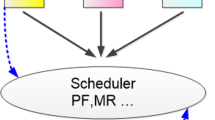Abstract
It is well known that IEEE 802.11 based MAC provides max–min fairness to all nodes even in a multi-rate WLAN. However, the max–min fairness may not always be the preferred fairness criteria as it significantly reduces overall system throughput. In this paper, we explore the proportional fairness and the time fairness. First, we obtain a condition that must be satisfied by the attempt probabilities to achieve proportional fairness. Using this condition, we propose a stochastic approximation based on-line algorithm that tunes attempt probabilities to achieve proportional fairness. The proposed algorithm can be implemented in a distributed fashion, and can provide optimal performance even when node uses a rate adaptation scheme. Next, we show that the time fairness is a special case of weighted max–min fairness with the weight for a node is equal to its transmission rate. Thus, the existing algorithms to achieve weighted max–min fairness can be used to achieve time fairness as well. This exposition also demonstrates that the proportional fairness and the time fairness are not the same contrary to what was conjectured. Performance comparison of various fairness criteria is done through ns-3 simulations. Simulation results show that time fair schemes achieve the highest throughput, and the sum of logarithm of individual node’s throughputs under the time fairness is close to that under a proportionally fair scheme.



Similar content being viewed by others
References
Banchs, A., Serrano, P., & Oliver, H. (2007). Proportional fair throughput allocation in multirate IEEE 802.11e wireless LANs. Wireless Network, 13(5), 649–662.
Bianchi, G. (2000). Performance analysis of the IEEE 802.11 distributed coordination function. IEEE Journal on Selected Areas in Communications, 18(3), 535–547.
Bianchi, G., Fratta, L., & Oliveri, M. (1996). Performance evaluation and enhancement of the CSMA/CA MAC protocol for 802.11 wireless LANs. In PIMRC’96, Vol. 2, pp. 392–396.
Blum, J. (1954). Multidimensional stochastic approximation methods. The Annals of Mathematical Statistics, 25(4), 737–744.
Bononi, L., Conti, M., & Gregori, E. (2004). Runtime optimization of IEEE 802.11 wireless LANs performance. The Annals of Mathematical Statistics, 15(1), 66–80.
Borkar, V. (2009). Stochastic approximation: A dynamical systems viewpoint. Haryana: Hindustan Book Agency.
Calì, F., Conti, M., & Gregori, E. (2000). IEEE 802.11 protocol: Design and performance evaluation of an adaptive backoff mechanism. The Annals of Mathematical Statistics, 18(9), 1774–1786.
Champati, J., & Chaporkar, P. (2011). Proportionally fair resource allocation in multi-rate WLANs. In IEEE NCC’11.
Garroppo, R., Giordano, S., Lucetti, S., & Tavanti, L. (2007). Providing air-time usage fairness in IEEE 802.11 networks with the deficit transmission time (DTT) scheduler. The Annals of Mathematical Statistics, 13(4), 481–495.
Hegde, M., Kumar, P., Vasudev, K., Sowmya, N., Anand, S., Kumar, A., et al. (2013). Experiences with a centralized scheduling approach for performance management of IEEE 802.11 wireless lans. The Annals of Mathematical Statistics, 21(2), 648–662.
Heusse, M., Rousseau, F., Guillier, R., & Duda, A. (2005). Idle sense: An optimal access method for high throughput and fairness in rate diverse wireless LANs. In ACM SIGCOMM’05, pp. 121–132.
Hu, S., Li, J., & Pan, G. (2014). Performance and fairness enhancement in IEEE 802.11 wlan networks. The Annals of Mathematical Statistics, 68(7), 667–675.
IEEE: IEEE 802.11 Part 11: Wireless LAN Medium Access Control (MAC) and Physical Layer (PHY) Specifications (2007).
Jiang, L., & Liew, S. (2005). Proportional fairness in wireless lans and ad hoc networks. The Annals of Mathematical Statistics, 3, 1551–1556.
Kim, J., Kim, S., Choi, S., & Qiao, D. (2006). CARA: Collision-aware rate adaptation for IEEE 802.11 WLANs. In IEEE InfoCom’06. Barcelona, Spain
Krishnan, S., & Chaporkar, P. (2010). Stochastic approximation algorithm for optimal throughput performance of wireless LANs. ArXiv e-prints
Lin, P., & Chou, W. I. (2011). Achieving airtime fairness of delay-sensitive applications in multirate ieee 802.11 wireless lans. The Annals of Mathematical Statistics, 49(9), 169–175.
Liu, J. S. (2008). Achieving weighted fairness in IEEE 802.11-based WLANs: Models and analysis. The Annals of Mathematical Statistics, 7(6), 605–615.
Ma, H., Li, X., Li, H., Zhang, P., Luo, S., & Yuan, C. (2004). Dynamic optimization of IEEE 802.11 CSMA/CA based on the number of competing stations. In IEEE ICC’04, Vol. 1, pp. 191–195.
Mohsenian-Rad, A., Huang, J., Chiang, M., & Wong, V. (2009). Utility-optimal random access: Reduced complexity, fast convergence, and robust performance. The Annals of Mathematical Statistics, 8(2), 898–911.
Qiao, D., & Shin, K. (2002). Achieving efficient channel utilization and weighted fairness for data communications in IEEE 802.11 WLAN under the DCF. In IEEE IWQoS, pp. 227–236
Rad, A., Huang, J., Chiang, M., & Wong, V. (2009). Utility-optimal random access without message passing. The Annals of Mathematical Statistics, 8(3), 1073–1079.
Radunovic, B., & Boudec, J. Y. L. (2004). Rate performance objectives of multihop wireless networks. In INFOCOM’04, Vol. 3, pp. 1916–1927.
Robbins, H., & Monro, S. (1951). A stochastic approximation method. The Annals of Mathematical Statistics, 22(3), 400–407.
Rudin, W. (1986). Real and complex analysis. New York: McGraw-Hill Science/Engineering/Math.
Schwarz, S., Mehlführer, C., & Rupp, M. (2011). Throughput maximizing multiuser scheduling with adjustable fairness. In IEEE ICC’11. Kyoto, Japan
Tan, G., & Guttag, J. (2004). Time-based fairness improves performance in multi-rate WLANs. ATEC ’04 (pp. 23–23). Berkeley, CA.
Tinnirello, I., Bianchi, G., & Xiao, Y. (2010). Refinements on IEEE 802.11 distributed coordination function modeling approaches. The Annals of Mathematical Statistics, 59(3), 1055–1067.
Wolff, R. (1989). Stochastic modeling and the theory of queues. New Jersey: Prentice Hall.
Author information
Authors and Affiliations
Corresponding author
Rights and permissions
About this article
Cite this article
Krishnan, S., Chaporkar, P. Stochastic approximation based on-line algorithm for fairness in multi-rate wireless LANs. Wireless Netw 23, 1563–1574 (2017). https://doi.org/10.1007/s11276-016-1243-x
Published:
Issue Date:
DOI: https://doi.org/10.1007/s11276-016-1243-x




